
|
Astronomy Picture Of the Day (APOD)
 Space Stations in Low Earth Orbit
Space Stations in Low Earth Orbit
6.01.2023
On January 3, two space stations already illuminated by sunlight in low Earth orbit crossed this dark predawn sky. Moving west to east (left to right) across the composited timelapse image China's Tiangong Space Station traced the upper trail captured more than an hour before the local sunrise.
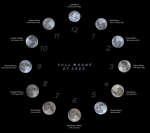 Moon O Clock 2022
Moon O Clock 2022
5.01.2023
The first Full Moon of 2023 is in the sky tonight opposite the Sun at 23:08 UTC. Big and beautiful, the Moon at its brightest phase should be easy to spot. Still...
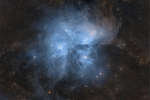 Messier 45: The Daughters of Atlas and Pleione
Messier 45: The Daughters of Atlas and Pleione
4.01.2023
Hurtling through a cosmic dust cloud a mere 400 light-years away, the lovely Pleiades or Seven Sisters open star cluster is well-known for its striking blue reflection nebulae. It lies in the night sky toward the constellation Taurus and the Orion Arm of our Milky Way galaxy.
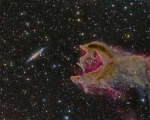 APOD: 2023 January 4 Б CG4: The Globule and the Galaxy
APOD: 2023 January 4 Б CG4: The Globule and the Galaxy
3.01.2023
Can a gas cloud eat a galaxy? It's not even close. The "claw" of this odd looking "creature" in the featured photo is a gas cloud known as a cometary globule. This globule, however, has ruptured. Cometary globules are typically characterized by dusty heads and elongated tails.
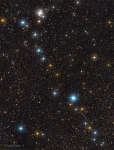 APOD: 2023 January 3 Б Kembles Cascade of Stars
APOD: 2023 January 3 Б Kembles Cascade of Stars
2.01.2023
This line of stars is real. A little too faint to see with the unaided eye, KembleБs Cascade of stars inspires awe when seen with binoculars. Like the Big Dipper though, KembleБs Cascade is an asterism, not a constellation. The asterism is visible in the northern sky toward the long-necked constellation of the Giraffe (Camelopardalis).
 APOD: 2023 January 2 Б After Sunset Planet Parade
APOD: 2023 January 2 Б After Sunset Planet Parade
1.01.2023
Look up tonight and see a whole bunch of planets. Just after sunset, looking west, planets Venus, Saturn, Jupiter and Mars will all be simultaneously visible. Listed west to east, this planetary lineup will have Venus nearest the horizon, but setting shortly after the Sun.
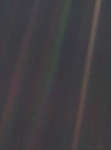 The Largest Rock in our Solar System
The Largest Rock in our Solar System
31.12.2022
There, that dot on the right, that's the largest rock known in our Solar System. It is larger than every known asteroid, moon, and comet nucleus. It is larger than any other local rocky planet.
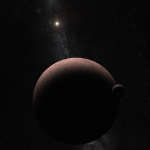 Moon over Makemake
Moon over Makemake
30.12.2022
Makemake (sounds like MAH-kay MAH-kay), second brightest dwarf planet of the Kuiper belt, has a moon. Nicknamed MK2, Makemake's moon reflects sunlight with a charcoal-dark surface, about 1,300 times fainter than its parent body.
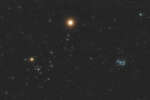 Mars and the Star Clusters
Mars and the Star Clusters
29.12.2022
At this year's end Mars still shines brightly in planet Earth's night as it wanders through the head-strong constellation Taurus. Its bright yellowish hue dominates this starry field of view that includes Taurus' alpha star Aldebaran and the Hyades and Pleiades star clusters.
 Horsehead and Flame
Horsehead and Flame
28.12.2022
The Horsehead Nebula, famous celestial dark marking also known as Barnard 33, is notched against a background glow of emission nebulae in this sharp cosmic skyscape. About five light-years "tall" the Horsehead lies some 1,500 light-years away in the constellation of Orion.
|
January February March April May June July August September October November December |
|||||||||||||||||||||||||||||||||||||||||||||||||